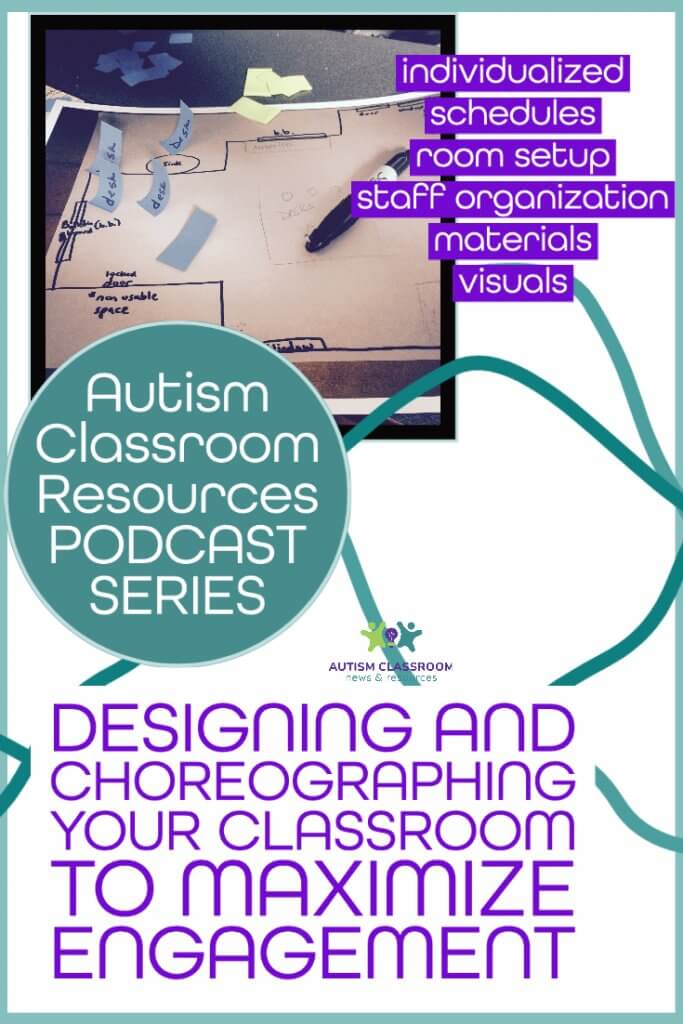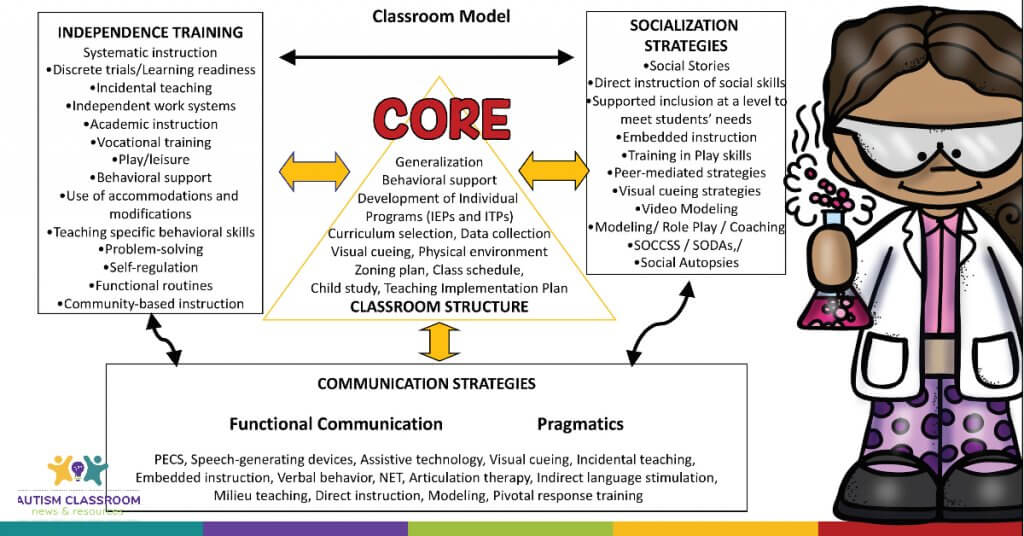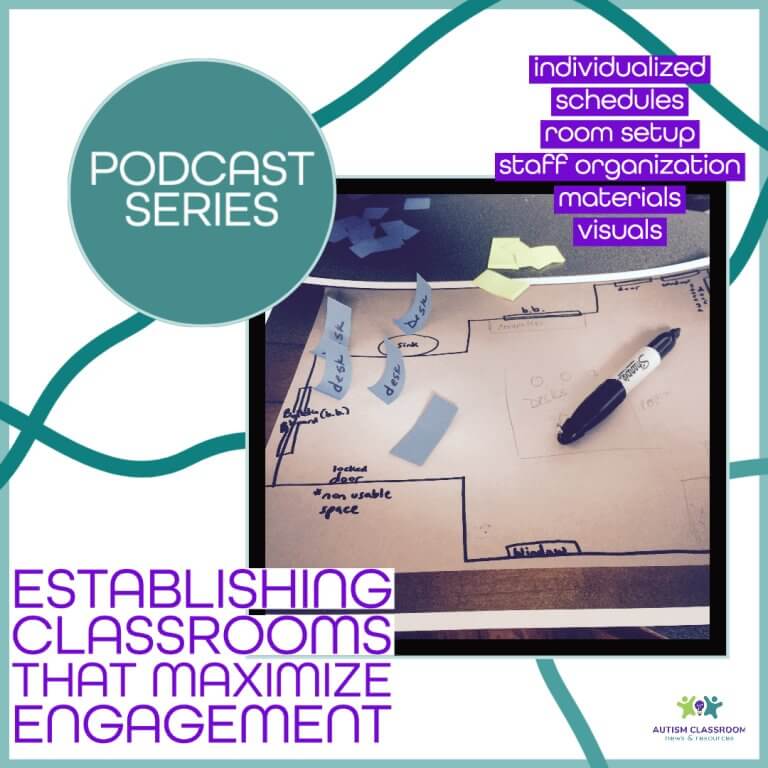Welcome back to The Autism Classroom Resources Podcast. I am Chris Reeve. I’m your host. I’m very excited to kick off our series on setting up classrooms to maximize engagement. My fancier name is to call it designing and choreographing your classroom to maximize engagement.
Special Education Classroom Design with Demonstration Classrooms
And just to give you a little background on why this excites me, there was a time in my life for many, many years that I felt that my entire job was setting up classrooms. We had a model when I used to work at Nova Southeastern University for the Autism Consortium, where we went into classrooms. Within a week, we would restructure the classroom, restructure the schedule, restructure the staffing schedule, put it together, put the visuals in place. Then on the fourth day, we would run the classroom and let the staff stand back and watch us. On the fifth day, we would then support them as they were running it. And then we would do follow up over time.
We could do this multiple times a year. So we got a really good crash course in designing classrooms of all different types in all different places. We worked in tiny classrooms that used to be closets. And we worked in giant classrooms that I couldn’t believe how big they were. In addition, we worked in private schools, public schools, preschool elementary, middle school, high school we’ve even designed some adult programs. We did a lot of different variety. All of those classrooms were not autism or even autism specific.
In addition to just our formal demonstration classrooms, I spent most of the beginning of school for 15 years in the classroom, setting up classrooms with teachers, for the districts that I worked with to get them off to a good start.
It Pays to Put the Time In Up Front
I am a very strong believer that if we should put in the time upfront to really structure our classrooms well. And by that, I mean it’s about more than just where we put our furniture. We need to design on our schedule and tailor our classroom to the needs of the students is going to serve.
Putting the time up front, got us off to a strong start. And we had a lot less stress from fixing things on the fly. That made life much easier in the long run because we already had our systems in place.
Focus of the Special Education Classroom Design Series
So what I’m going to focus on in this series are going to be systems and strategies that help you get to know your students, design your schedule, your classroom, your visuals, your supports, your staff schedule to meet their needs. And this will work for any special education classroom. The same principles will work in for students who are included in general ed classes. And they will work for all ages. Now a lot of this will be visual. So I’ll share some of that on the blog and refer you back there as we go. I kind of miss setting up classrooms. OK, I don’t miss starting school. I started school eight times one year. Yes, I was there on the first day of school in eight different school districts in their classrooms having set them up. So that part I don’t miss. I don’t miss the airplanes, but I do miss the excitement of we’ve got this blank slate.
Today’s Episode on Designing Special Education Classrooms
Today I’m just going to go over what the model is and what our intent, what our focus is. And then the steps that you’re going to hear in the rest of the series. And I will be adding in some tidbits as we go that will help us.
Tips for Virtual as Well as Brick and Mortar Classes
At the time that I’m recording this, we are getting ready for going back to school in the midst of the coronavirus pandemic. So I will be adding some tips about social distancing and there will be some strategies that will help with distance or blended learning as well. Just don’t feel like I have forgotten what we’re in the midst stuff. I am super pumped for this series. As I said, this is one of my favorite things to talk about.
So let’s get started
Special Education Classroom Design Model
The entire point of choreographing and designing your classroom is to design a classroom that runs itself that allows for high levels of engagement. The Council for Exceptional Children in their high leverage practices makes a point that students in special education need high levels of explicit instruction. And they need to be kept engaged in learning throughout the day.
They need high levels of engagement. And that’s something that we’ve done across the board with the special education classroom design model that we set up. My colleague Susan Kabot and I worked together for many years. Over time, from all of our time setting up classrooms, we developed a lot of systems. We developed a lot of strategies and a model that we follow to set our classrooms up.
It’s All About the Core
I’m a behavior analyst. Sue is a speech pathologist and a special education teacher. And we’ve both been administrators and held a lot of different roles. But our model for setting up a class has, at the center, a strong core.
You know, how in exercise classes they tell you, you always have to work your core, because the rest of your strength is coming from your core? The same is true for our classrooms.
What is a Classroom Core?
We have to make sure that our core of the classroom is well designed and structured so that we can focus on the interventions. We have lots of evidence-based interventions for all different types of students with special education needs. But if we must have a well-designed classroom that is focused on the individual needs of the students in it. That includes a strong physical environment, a well-organized staff, a well organized, predictable schedule, clear curriculum, data collection, procedures, and behavioral supports. Especially the preventive antecedent strategies, using things like visuals and strategies to keep our kids engaged so that we don’t see as many behaviors.
All of those things make up the core of a good classroom, just like a general ed teacher would tell you that her classroom management strategy makes up the core of the classroom.
Without a Strong Core
Because without a strong core, I can’t use ABA discrete trials. You can’t use a SCERTS model. We can’t use the Picture Exchange Communication System. You can’t teach LAMP or core vocabulary if everybody is not focused on learning.
So the model in the blog post will show you the different independence socialization and communication strategies on the outside. But they will all collapse on each other if you don’t have a strong core.
So think of me as your personal trainer in developing your strong core in your classroom.
No Two Classrooms Are the Same
Our classroom is going to change over the years. I rarely see a schedule that can carry from year to year. I never see a zoning plan that can carry from year to year. Our focus is to integrate our effective educational and behavioral evidence based practices and rest them on the core of an efficiently structured learning environment.
The key to that is that every class looks different because we have to have individualized programming that is guided by knowing how we are going to implement every student’s IEP and curriculum plan. For every student, we need to know, what are our goals and objectives? What do we need to teach? We need to have planned out how we’re going to teach that skill. Also, we need to know where in our schedule and in the physical environment of our classroom, we are going to teach that skill. And we need to know who we are tagging with the responsibility to teach that skill.
So that’s going to be our first step, and I’ll talk about that next week.
Model Classroom Characteristics
Let’s talk for a minute just about the elements that make up this classroom. We are, as I said, looking for high levels of engagement. The special education classroom design has to result in high levels of engagement. Here are the important elements.
Well Organized Physical Environment
Also, we want a well organized physical environment. If I keep moving activities from act from area to area in the room. So one day we do reading over here. And one day we do reading over there. It’s going to be very confusing. It’s really important that we set up a physical environment. In the first few weeks we will make modifications to it. But we set up a physical environment where the students can know, when I come here, this is what I do. When I go there, this is what I do. Because the less they have to spend time focused on “What are we doing? What? What?” The more, they’re going to be able to focus on what you’re trying to teach them. And that is the point.
Clear Environmental Cues
We also want to make sure that within that environment, we have clear environmental cues. I think one of the things that the pandemic has really taught us is that we need clear environmental cues. I’ve seen so many visual supports show up now.
They show people what six feet away from someone, how far away from the cashier or the line should you stand in the grocery store? How far is six feet away from somebody getting milk out of the refrigerator?
So I think it’s important to really make sure we have clear environmental cues so our students don’t have to worry about where they are. They don’t have to think whether they’re in the right place or the wrong place. That’s going to be critical.
Routine & Predictability
We want to make sure that we have a classroom that’s set up with routine and predictability. Nobody wants to live in chaos. Chaos means I spend all my time worrying about what I’m going to do next, where I’m going to go, what I’m going to say, what I have to do, what do I have to have with me routine?
And predictability means I can do it without thinking about it. And when I can do it without thinking about it, I can focus on what I’m doing.
Driving a Car?
Think of it as driving a car, most of us have had experiences driving our car, where I get in the car. I got home. I have no idea how I got there because my brain did 15 other things she’ll stopped at the stop sign, stopped at the stoplight. And I waited for the person crossing the street. Amazingly, I managed to get home safely. I might’ve been a little distracted, but I was able to drive the car without taking it by full attention.
Now, when you first get started in a classroom, it takes your full attention. Just like when a 16 year old starts driving a car. I really hope it takes their full attention. But as you do it more and more, the easier it gets.
Spend the Time Up Front
So just know that when we’re talking about this whole system, it’s hard at first. It takes more time. The first time you do it, the more that you do it, the easier it gets.
Individualized Instruction
We want to make sure that we have the implementation of appropriate curriculum items that are tied to our state standards. We all know that that’s important.
We need to make sure that we know where, and when in the day we are doing that. We want to make sure that we’ve identified our assessment, our data collection, our progress monitoring, and our intervention strategies, linked to specific IEP goals as well, Teachers need to be able to walk into an IEP meeting and be able to talk the walk. They need to be able to talk about what they do.
And finally, all of this adds up to making sure that we can provide individualized instruction, which is the key in the heart of special education. It’s the key in the heart of applied behavior analysis. If you’re a behavior analyst, I’m not a big fan of, “We always do it this way.” Because it’s not good science and it’s not good special education. So there’s always a different way to do things. And we have to make sure that what we’re doing is meeting those individual needs.
As we go through to set up this model, we have to learn about the student. So I’m going to talk about my Teaching Implementation Plan, the TIP. Some of you may have read about it on the blog. If not, I will point you there.
Going Virtual
That’s what we’re going to talk about next week. I think it’s going to be an even more critical component as we have distance learning in some situations going forward. Particularly if we have blended learning, then we need to organize our time, which essentially means developing our classroom schedule. And our classroom schedule is based on the individual needs of our students. We then organize our physical space so that it matches our schedule. And so it supports the needs of our students.
Now this year, designing our physical space is going to be a little difficult, different because we, I have social distancing to think about. So we’ll talk a little bit about that.
Organizing Staff
We then need to organize our staff. Now, granted, all of things are happening in your brain to some degree together. Like if I know I have a very small classroom, I know I can’t have 15 centers. There is no room for them. So I know that when I do my schedule, when I find out that I made everybody go in a weird rotation system where they cross each other, instead of going around a circle in the physical environment, I changed my schedule. So it is a reciprocal process.
Organizing staff is the same way. I’ve created tons and tons of beautiful schedules that I absolutely adored. Until I found out that nobody got to eat lunch and nobody got to go to the bathroom. And that should not be the reality of what we’re trying to create.
Building Classroom Teams
And usually at the end of that, we then also talk about building classroom teams because you cannot schedule and work with staff without building a strong collaborative team with the staff in the classroom.
But you’ve got a head start on that. I actually started this podcast earlier this year with a five episode series on Building Classroom Teams.
Get a Jumpstart in the Special Educator Academy
If you just can’t wait for this podcast series, and you want to get a jumpstart, you can definitely come over to the Special Educator Academy. Where we have a whole course on setting up your classroom, along with all of the tools and the materials that you need to follow. All the steps that I just described. I’m going to give you the short version as we go through the series, and I will point you to some other resources as well. But we have free 7-day trial at the Special Educator Academy. We can help you get started. We also have a ton of training on distance learning that we can help with.
I hope you’ll come back next Sunday and subscribe. So it downloads automatically on iTunes share review if you like it. And we will be talking about individualizing our programs next week. Thank you so much for your time. I know that it is precious. I am thinking of everyone as we think about going back to school and hopefully I’ll see you next week.







